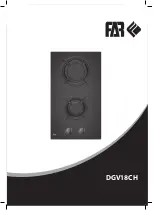
GB
17
!
If the hob is fitted above a built-in oven, the hob
and the oven must be connected to the mains
separately for safety reasons and to simplify
operations when it is necessary to pull the oven out
for some reason.
This appliance conforms to the
following European Economic
Community directives:
- 73/23/EEC dated 19/02/73 (Low Voltage) and
subsequent amendments;
- 89/336/EEC dated 03/05/89 (Electromagnetic
Compatibility) and subsequent amendments;
- 93/68/EEC dated 22/07/93 and subsequent
amendments.
Electrical connections
Voltage,
Frequency
Fuses,
Sections
FR-AT-BE-DE-GP--
ES-IE-IL-IS-IT-LU-
RE-FI-GB-GR-PT--
SE-MA-NZ
230V-1+N~50 Hz
25 A*
2,5 mm²
FR-BE-NO
230V-2~50/60 Hz
25 A*
2,5 mm²
FR-BE-CH-DE-AT--
ES-IL-IT-NZ-PT-
MA- LU-SE-IS-NL
400V2-N~50 Hz
16 A*
1,5 mm²
FR-BE-NO
230V3~50 Hz
16 A*
1,5 mm²
NL
230V2+2-N~50 Hz
16 A*
1,5 mm²
CY-AU-NZ-KW-MT
240V-1+N~50 Hz
25 A*
2,5 mm²
* Application of the simultaneity coefficient in accordance with
cei 60335-2-6 norm
L
N
1
2
3
4
5
L1
L2
N2
N1
1
2
3
4
5
L1
L2
N
1
2
3
4
5
L1
L2
L3
1
2
3
4
5
L1
L2
N2
N1
1
2
3
4
5
L
N
1
2
3
4
5
Disposal
When disposing of packaging material: observe
local legislation so that the packaging may be
reused.
The European Directive 2002/96/EC relating to
Waste Electrical and Electronic Equipment
(WEEE) states that household appliances should
not be disposed of using the normal solid urban
waste cycle. Exhausted appliances should be
collected separately in order to optimise the cost
of re-using and recycling the materials inside the
machine, while preventing potential damage to
the atmosphere and to public health. The
crossed-out dustbin is marked on all products to
remind the owner of their obligations regarding
separated waste collection.
For further information relating to the correct
disposal of exhausted household appliances,
owners may contact the public service provided
or their local dealer.
















































